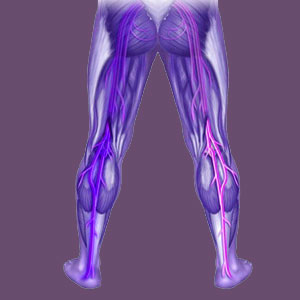
Pronated foot piriformis pain is created by postural issues caused by flat feet. Foot pronation is just one of many theories to explain functional piriformis pain and is often diagnosed by podiatrists, physical therapists and even some posturally-focused chiropractors.
Pronated feet have a bad reputation for eliciting back pain, joint pain and degeneration of the sacroiliac, hip, knee and ankle, as well as causing localized foot problems. More recently, pronation has been cited as a cause of many soft tissue pain issues, such as those which might affect the piriformis muscle.
While we see the evidence that foot hyperpronation can be the source of some types of negative health issues, we have also observed evidence that many of these diagnoses are faulty, with no evidence-based merit of pathology. Therefore, we will use this article to provide a balanced point of view on the idea that piriformis pain might be caused by flat feet.
Pronated Foot Piriformis Pain Background
Foot pronation can occur due to poor posture, poor shoes or flat feet. Chronic pronation of the feet is generally a result of the last explanation, since so many people demonstrate fallen arches in one or both feet. Over-pronation is defined as bearing the weight of the body on the side of the foot featuring the large toe, which is located on the inside of the foot. Typically, weight is meant to be born across the foot rather evenly, but pronated feet tend to focus the force of the body, as well as ambulation impact on the first and second toe bones.
Podiatrists and posture experts have long taught that pathology at the level of the feet will create symptoms up the body all the way to the neck and head. This is the foundation theory of pain and parts of this ideology are highly credible, while other aspects seem a bit exaggerated and unenlightened.
Therefore, piriformis pain due to pronated feet describes a condition wherein the piriformis muscle suffers some type of symptomatic activity that originates in the demonstration of poor standing and walking technique due to flat feet.
Pronated Feet Pain Mechanism
When the feet roll inward, atypical stress is suffered by the foot and ankle, since the weight and movement of the body is not borne correctly. However, the stress suffered is also transferred upwards, much in the way that a faulty foundation could compromise the structural integrity and stability of a tall building.
Foot pronation stress can affect the ankles, knees, hips, sacroiliac and lumbar spinal joints, as well as changing the curvature of the lumbar spine. Likewise, soft tissues which attach and regulate these joints can also be affected, creating chronic strain conditions, imbalances and other possible painful consequences to due to postural and gait changes associated with flat feet.
Remember that the piriformis muscle is attached at both the upper leg and the sacrum, so it can be affected doubly by changes enacted at ground level. The muscle might become overly taut or overly lax and might even spasm, potentially compressing the sciatic nerve and creating piriformis syndrome.
Pronated Foot Piriformis Pain Diagnostic Evaluation
We embrace the idea that actions in one area of the body are likely to have equal reactions elsewhere. Therefore, we see the plausibility of suffering piriformis pain or piriformis syndrome as a result of foot pronation. However, that being said, we also must provide the counterpoint argument, which is just as logical and valid given the findings of research and clinical medical science.
The human anatomy is blessed with the almost miraculous ability to adapt to structural change and functional alteration. We have seen countless patients who demonstrate a wide range of structural and functional issues, including leg length discrepancies, spinal abnormalities, pelvic misalignments, joint irregularities and flat feet perform perfectly normally in all regards and not report suffering any symptoms at all. Furthermore, we have seen many patients whose pain was blamed on similar or identical issues, including foot pronation, yet they still experienced chronic long-term agony even after their “problem” was addressed and resolved using conservative or invasive care practices.
With this evidence, the equation is balanced and we now understand why the debate over the validity of flat-footed piriformis pain remains a hotly argued subject matter. We tend to accept that some diagnoses might be valid and correct, while many others might be using the flat feet as a scapegoat when it comes to explaining piriformis symptomology.
We highly recommend that patients faced with this diagnosis of pronated foot piriformis pain seek multiple diagnostic opinions from different types of care providers to improve their chances of accurate and successful diagnostic processing and satisfying treatment.
Piriformis Pain > Causes of Piriformis Pain > Pronated Foot Piriformis Pain





